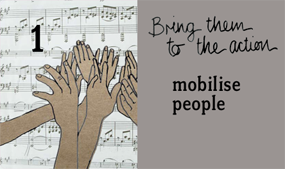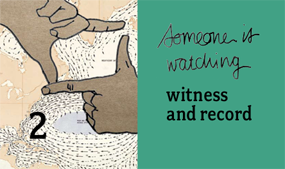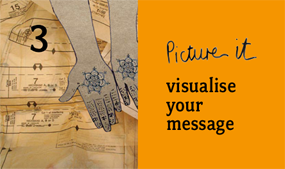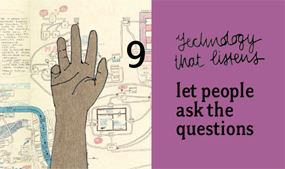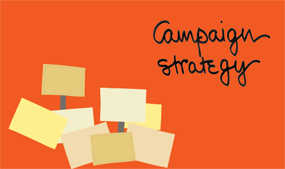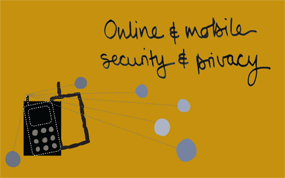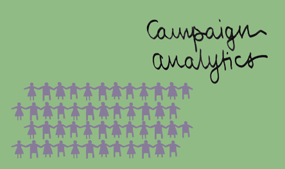10 Tactics: explore the content
Explore the content included in 10 Tactics here on this webpage or by downloading a pdf version.
The 10 Tactics film and the accompanying tactics cards provide examples of info-activism from around the world. The 5 basics cards offer advice, tips and activities for you the work through as you plan your own info-activism initiatives.
A new poster has been created for 10 Tactics. Download it here!
Also included in this workbox is a gallery of images from 10 Tactics that can be used in presentations and trainings.
The 10 Tactics film has also been divided into the individual stories from the film. Explore the video stories here.
Download a pdf version of this page to help you quickly find what you are looking for.
|
Tactic 1. Bring them to the action: Mobilise people
This tactic is good to use when you want to support people to come together, online and in person, around a cause.
|
|
Video Volunteers Demand Land Rights: Citizen journalists in India
Interview: Namita Singh, Video Volunteers, India video
Tools used: Digital video cameras, editing software, YouTube, widescreen projectors, VCD/DVDs
Pink Chaddi Campaign: Women's advocates in India
Interview: Namita Malhotra, Alternative Law Forum, India
Tools used: Facebook, Blogspot, Flickr, posters, digital cameras
Using a Friendless Profile for Visibility: LGBT advocates in Lebanon
Interview: Rebecca Saab Saade Technologist, Lebanon.
Tools used: Facebook
TheyWorkForYou, MySociety UK
Interview: Tom Steinberg, My Society
Tools used: Custom-built content management system (CMS) made from open source software, Wordpress, Facebook
Go to the tactic | Download the pdf here
|
|
Tactic 2. Someone is watching: Witness and record
This tactic is good for ensuring that people have the power to capture rights abuses as they happen.
|
|
The Targuist Sniper: Anonymous advocate in Morocco
Interview: Sami Ben Gharbia, Global Voices, The Netherlands
Tools used: Video camera, video editing software, YouTube, blogs
The Saffron Revolution Bloggers and advocates in Burma
Interview: 'Aung', Rights advocate
Tools used: Blogs, news reports, digital cameras, mobile phones, photos
Remembering Neda, Advocates in Iran
Tools used: Mobile phone cameras, email, YouTube, Twitter, Facebook, blogs
Go to the tactic | Download the pdf here
|
|
Tactic 3. Picture it: Visualise your message
This tactic is good for communicating creatively across different languages and literacies, and for capturing people’s attention.
|
|
Animating Folklore with a Feminist Twist: UK/Women and Memory Forum Cairo, Egypt
Interview: Tessa Lewin, Institute of Development Studies
Tools used: Adobe software (Photoshop, After Effects and Premiere)
Mapping a Conflict in Real Time, Lebanon
Interview: Muzna Al-Masri, Samidoun, Lebanon
Tools used: Adobe Illustrator, Blogspot, Wordpress
Putting Torture on the President's Map, Tunisia
Interview: Sami Ben Gharbia, Co-founder Nawaat.org
Tools used: Google Earth, Google Maps, YouTube
350.org: International Day of Climate Action
Interview: Phil Aroneanu, 350.org, United States
Tools used: YouTube, Facebook, Orkut, MySpace, Twitter and Zandy.
Go to the tactic | Download the pdf here
|
|
Tactic 4. No one is listening?: Amplify personal stories
This tactic is useful when people affected by the issue are not being consulted, and as a way to give an issue depth that resonates with the target audience.
|
|
Women’s Net: Digital Storytelling by women who have experienced violence, Southern Africa
Interview: Sally-Jean Shackleton, Women’sNet, South Africa
Tools used: video cameras, digital animation, digital video editing software, YouTube, blip.tv
A Duty to Protect: Justice for Child Soldiers in the D.R.C. by Ajedi-Ka PES/Child Soldier Project and WITNESS, Democratic Republic of the Congo
Interview: Sam Gregory, WITNESS
Tools used: video cameras, digital video editing software, website
Blank Noise: By women against urban street harassment in India
Interview: Cheekay Cinco, Association for Progressive Communications, Philippines
Tools used: Blogspot.com, Facebook, Flickr
We the Women, Saudi Arabia
Interview: Areej Khan, project director
Tools used: Facebook, Flickr, YouTube
Go to the tactic | Download the pdf here
|
|
Tactic 5. Provoke a smile: Just add humour
This tactic is useful when people affected by the issue are not being consulted, and as a way to give an issue depth that resonates with the target audience.
|
|
Remixed Presidential Posters Artists and Advocates in Egypt
Interview: Alaa Abd El Fattah, Technologist, Egypt
Tools used: Digital photo editing software, Facebook, blogs, email, YouTube
Karaoke Videos for Human Rights, Thailand and Cambodia
Asia Pacific Network of Sex Workers
Interview: Dale C. Kongmont, Asia Pacific Network of Sex Workers, Thailand
"Give Lukashenko his own Lu-net!": Advocates in Belarus
Interview: Sami Ben Gharbia, Global Voices, The Netherlands
Tools used: Blogs, LiveJournal, YouTube
Flash mobs in Belarus: Belarusian advocates
Interview: Zhenya Mantsevich, a journalist and blogger, Belarus
Tools used: LiveJournal, ICQ (chat programme) and SMS
Go to the tactic | Download the pdf here
|
|
Tactic 6. Understand your connections: Manage your contacts
This tactic is good for understanding your connections and relationships so you can make the most of your networks.
|
|
Organise and mobilise your contacts: Open source software advocates and programmers
Interview: Michal Mach, CiviCRM, Poland
Tools used: CiviCRM and Drupal or Joomla or a standalone content management system (CMS)
Providing targeted reconstruction information: By Mercy Corps and Frontline SMS in Indonesia
Interview: Ken Banks, FrontlineSMS, UK
Tools used: FrontlineSMS, mobile phones
Kleercut campaign for the environment: By Greenpeace, United States
Interview: Richard Brooks, Greenpeace
Tools used: Drupal for the website and CiviCRM to manage contacts.
Go to the tactic | Download the pdf here
|
|
Tactic 7. Make it simple: use complex data
This tactic is good to use when you need to present and share complex or hard-to-access information with the people who need it most.
|
|
Mapping Farm Subsidy Payments in Sweden: By FarmSubsidy.org and advocates in Sweden
Interview: Jack Thurston, FarmSubsidy.org, UK
Tools used: Freedom of Information Act (FOIA) requests, Xapian database (open source software), Google Maps, website
Visualising the Crisis in Darfur: By advocates/technologists working with the US Holocaust Memorial Museum
Interview: Mikel Maron, OpenStreetMap, USA
Tools used: Google Earth, data from the United Nations and Amnesty International, photos and videos, website.
Fair Play Alliance: Bratislava, Slovakia
Zuzana Wienk, Fair Play
Tools used: Custom-built database, using open source tools (mySQL, Apache server, and PHP).
Go to the tactic | Download the pdf here
|
|
Tactic 8. Report it live: use collective intelligence
This tactic is good for creating or gathering information, reporting on public events such as elections or protests and responding to disasters or outbreaks.
|
|
Field Reporting the 2008 Mumbai Terror Attacks: By citizens of Mumbai
Interview: Dina Mehta, Researcher, India
Tools used: Twitter, Flickr, MySpace, blogging, mobile phones
Gathering Citizen Reports of Violence: By Foko and the Citizens of Madagascar
Interview: Ken Banks, FrontlineSMS, UK
Tools used: IntelliSMS, FrontlineSMS, Ushahidi, Twitter, mobile phones, blogging
Unsung Peace Heroes in Kenya: By Butterfly Works and Media Focus on Africa Foundation
Interview: Marten Schoonman, Media Focus on Africa, South Africa
Tools used: Ushahidi, mobile phones, Facebook, website.
Go to the tactic | Download the pdf here
|
|
Tactic 9. Technology that listens: let people ask the questions
This tactic is good for getting vital information to people when popular information or sources are incomplete or misleading, or when other forms of direct communication are difficult.
|
|
Budget Tracking by Citizens: By Social Development Network, Kenya
Interview: John Kipchumbah, Social Development Network, Kenya
Tools used: database (WampServer: Apache, PHP, MySQL), website, mobile phones
A Freedom Fone:for Zimbabweans: By Kubatana Trust
Interview: Brenda Burrell, Kubatana Trust of Zimbabwe, Zimbabwe
Tools used: FrontlineSMS, mobile phones, desktop computers to run Freedom Fone call-in system
MyQuestion, MyAnswer: OneWorld UK/Education as a Vaccine Against AIDS
Interview: Uju Ofomata, Oneworld, UK
Tools used: mobile platform customised from open source software (Apache web server, PHP application, MySql database), website, mobile phones
Go to the tactic | Download the pdf here
|
|
Tactic 10. Reveal the truth: Investigate and expose
This tactic is useful when you are able to collaborate with others to identify, share and act on evidence that is being concealed from the public or ignored by those who need to act.
|
|
Exposing Torture by Police in Egypt: By citizens/journalists in Egypt
Interview: Noha Atef, Tortureinegypt.net, Egypt
Tools used: Drupal for creating the website (before that, Blogspot), photos and videos, usually shot on and sent from mobile phones
Presidential Plane Spotting: By advocates in Tunisia
Interview: Sami Ben Gharbia, Global Voices, The Netherlands
Tools used: Planespotters’ websites (like Airliners.net) Google Earth, YouTube, Flickr.
Caught Between the Tiger and the Crocodile: Asia Pacific Network of Sex Workers (APNSW) & Women’s Network for Unity (WNU)
Interview: Dale Kongmont, Asia Pacific Network of Sex Workers (APNSW)
Tools used: Flip video cameras, digital video editing software (Final Cut Pro), blip.tv, YouTube, website.
Go to the tactic | Download the pdf here
|
BASIC CARDS
|
Campaign strategy
|
|
Provides basic information and activities that will help you create a campaign strategy. This strategy will help you to strategically select the right tactics and tools, craft your message, create a timeline, as well as implement, document and evaluate your campaign.
Activity 1: Identify problem - solution – change that is needed.
Activity 2: Map issue stakeholders and their relationships.
Activity 3: Move from stakeholders to target audiences.
Activity 4: Move from target audiences to choosing the right tactics.
Go to the card | Download the pdf here
|
|
Access to information
|
|
This card presents the basics about your right to access information and how to use this right as part of your advocacy strategy. It explains how to access government-held information and make information requests and how to respond if your request for information is denied. Your right to access public information.
Activity 1: Decide exactly what you want to know.
Activity 2: Try to find information that is already published.
Activity 3: Make an access to information request.
Go to the card | Download the pdf here
|
|
Think creatively
|
|
Even with very few resources, you can turn information into action – if you are creative. The activities included in this card will help you engage the participation of your colleagues, supporters and partners in a creative process to design campaigns that will inform, motivate and influence your target audience.
Activity 1: Identifying inspiring campaign actions.
Activity 2: Thinking outside-the-box to come up with fresh ideas.
Activity 3: Seeing an issue from the perspective of your target audience and participant groups.
Activity 4: Brainstorm and test out new ideas on different audiences.
Go to the card | Download the pdf here
|
|
Online and mobile, security and privacy
|
|
New technologies, such as mobile phones and the internet, are powerful tools for advocacy but using them to communicate sensitive information can create risks for you, your contacts, friends and colleagues. This card will help you access information securely and protect your data when using mobiles phones and the internet.
Activity 1: Identify your security risks.
Activity 2: Explore other privacy & security resources.
Go to the card | Download the pdf here
|
|
Campaign analytics
|
|
Built in to the online platforms and services you are using for info-activism are analytical tools that allow you to see who is accessing your online campaign and how they are using it. These tools can help you to see if the techniques you are using are actually working. This card explains how to track the dissemination of your campaign's message, follow public dialogue around your campaign issue and monitor the online behaviour of your targets, allies and opponents, using a variety of free tools.
Activity 1: Track your own campaign message online
Activity 2: Track the issue you are trying to resolve
Activity 3: Track your targets, allies and opponents
Go to the card | Download the pdf here
|
|


